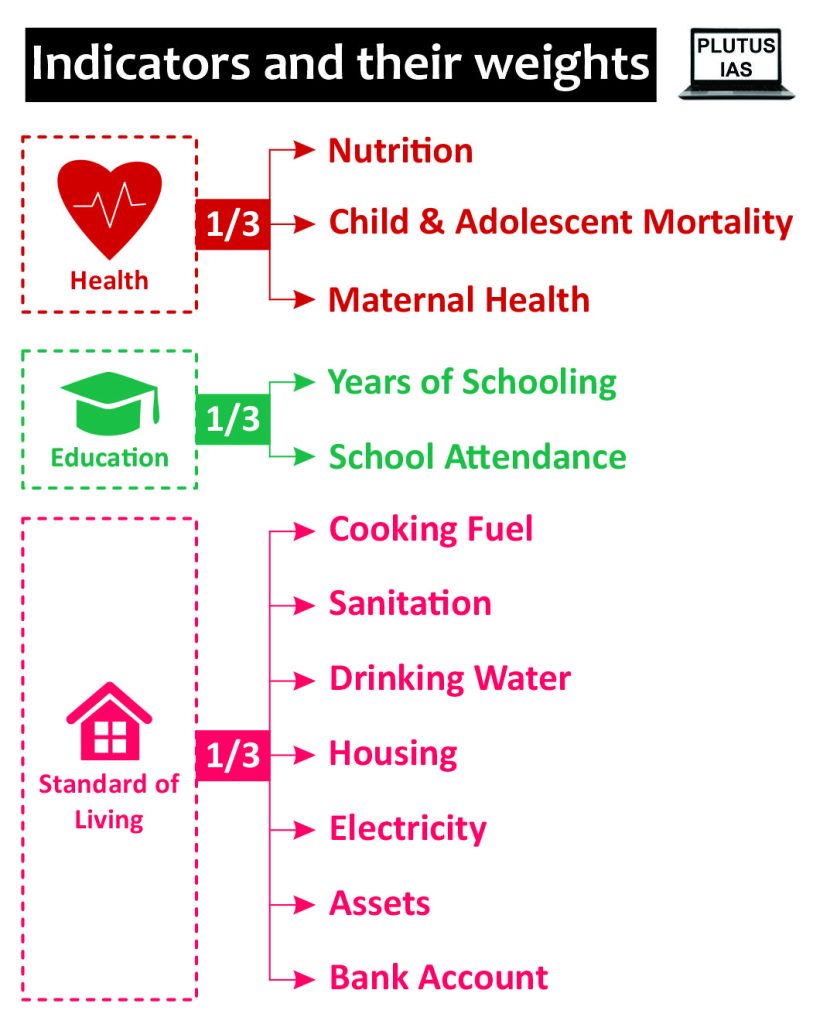17 Jan Multidimensional Poverty in India
Multidimensional Poverty
This article covers ‘Daily Current Affairs’ and the topic details of “Multidimensional Poverty in India’’. This topic is relevant in the “Social Issues and Governance ” section of the UPSC CSE exam.
UPSC Mains GS1 and GS2 Syllabus : Social Empowerment and issues, issues relating to poverty and hunger
Why in the News?
The NITI Aayog has produced a Discussion Paper titled “Multidimensional Poverty in India since 2005-06,” which states that 24.82 crore individuals have escaped Multidimensional Poverty over the last nine years. To further understand long-term poverty patterns, the discussion paper draws on data from National Family Health Surveys (NFHS) conducted in 2005-06, 2015-16, and 2019-21.
Key highlights of the report
-
Substantial Drop in Multidimensional Poverty:
India’s multidimensional poverty has decreased significantly, from 29.17% in 2013-14 to 11.28% in 2022-23, a 17.89% point decline. Approximately 24.82 crore people have left multidimensional poverty over the last nine years (2013-14 to 2022-23).
-
State-wise Decline:
Uttar Pradesh experienced the greatest drop, with 5.94 crore people leaving multidimensional poverty, followed by Bihar (3.77 crore), Madhya Pradesh, and Rajasthan.
-
Successful Achievement of SDG Objectives
Target 1.2 of the Sustainable Development Goals (SDG) is expected to be accomplished by India well before 2030. The target 1.2 targets “at least by half the proportion of men, women, and children of all ages living in poverty in all its dimensions according to national definitions.”
- All 12 MPI indicators have improved significantly, demonstrating development in the Health, Education, and Standard of Living dimensions.
-
Level of Deprivation
- Compared to 2005–06 and 2013–14, the Severity of Deprivation (SoD) decreased at a marginally slower rate between 2015–16 and 2019–21. Deprivations that the typical multidimensionally poor individual experiences are measured by SoD.
- In addition, because fewer years had passed since 2015–16, the decline in the proportion of MPI poor people in the overall population was faster than it had been during the previous ten years. The percentage of MPI poor people in India’s overall population in 2005–06 was 55.34%.
-
A few notable initiatives which the report highlights
- Deprivation has dramatically decreased as a result of initiatives like Poshan Abhiyan and Anaemia Mukt Bharat, both of which have greatly improved access to healthcare facilities.
- Under the National Food Security Act, the Targeted Public Distribution System, which is one of the biggest food security programmes in the world, serves 81.35 crore beneficiaries by supplying food grains to both urban and rural areas.
Multidimensional Poverty
- A poor individual may have several disadvantages at once, such as poor health or malnourishment, a lack of power or clean water, low-quality employment, or insufficient education. To fully grasp the actual nature of poverty, only one factor—such as income is not enough to capture the true reality of poverty.
- Multidimensional poverty is defined as having income or consumption below the $2.15 worldwide poverty level (as defined by the World Bank) in addition to deprivations in education and access to basic infrastructure. The World Bank sets the daily purchasing power parity (PPP) threshold for the international poverty line at USD 2.15.
What is the National Multidimensional Poverty Index?
- Since 2010, the United Nations Development Programme (UNDP) has incorporated MPI into its flagship Human Development Report. In this regard, the first edition of the national Multidimensional Poverty Index for India was released in 2021 by NITI Aayog.
- Goal: Since a nation’s national MPI statistic is customised to fit its priorities, each nation selects its own set of dimensions, indicators, weights, and cutoffs based on its own goals and circumstances.
- The headcount ratio and intensity of multidimensional poverty at the national, state/UT, and local levels are thoroughly examined in this research. The National Family Health Survey (NFHS)-4 reference period for 2015–16 served as the basis for the first report.
MPI Parameters & Methodology
- The solid Alkire and Foster (AF) technique is used in MPI’s worldwide methodology, which defines people as poor based on widely accepted criteria intended to assess acute poverty and also provides a complementary viewpoint to traditional monetary poverty measures.
- However, the National MPI covers 12 indicators while global MPI covers 10 indicators.Nutrition, maternal health, child and adolescent mortality, years of education, electricity, school attendance, assets, fuel for cooking, cleanliness, drinking water, housing, and bank accounts are a few of these.

Download plutus ias current affairs eng med 17th Jan 2024
Prelims practice questions
Q1) What is Multidimensional Poverty?
- a) A concept that solely focuses on economic well-being
- b) A measure that considers various dimensions of poverty beyond income
- c) A term used to describe poverty in only one specific region
- d) An approach that excludes education and health from poverty assessment
Answer: b
Q2) Which of the following is covered by the Multi-dimensional Poverty Index developed by Oxford Poverty and Human Development Initiative
1)Lack of access to resources, services, health care, and education at the household level
2)Parity in purchasing power at the national level
3)The size of the national budget deficit and GDP growth rate
Select the correct answer using the codes given below:
(a) 1 only
(b) 2 and 3 only
(c) 1 and 3 only
(d) 1, 2 and 3
Answer: a
Mains practice question
Q1) Discuss the concept of multidimensional poverty and how it differs from traditional measures of poverty.
Q2) Explore the interlinkages between multidimensional poverty and the United Nations Sustainable Development Goals (SDGs). How can addressing multidimensional poverty contribute to achieving the broader goals of sustainable development?
I am a content developer and have done my Post Graduation in Political Science. I have given 2 UPSC mains, 1 IB ACIO interview and have cleared UGC NET JRF too.



No Comments